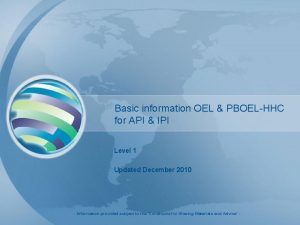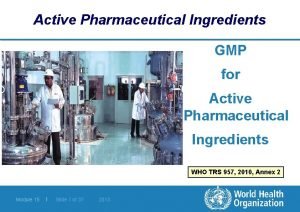Extraction of Active Ingredients for Pharmaceutical Use from

- Slides: 1

Extraction of Active Ingredients for Pharmaceutical Use from Freshwater Sapropel in Latvia 23221 Aneka Klavina, Ivars Vanadzins, Linda Dobkevica, Agris Auce, Laura Komarovska Rīga Stradiņš University, Institute for Occupational Safety and Environmental Health, Latvia Introduction Results Sapropel has been used for various purposes for many centuries. In Latvia sapropel has been used in agriculture, in construction as building material and in cosmetic manufacturing, in balneology and in medicine, especially, in pharmacy as biological active component. To make different drug forms in pharmacy use sapropel extract. Previously sapropel has been generally used in raw forms and there is no common accepted method or standard method for obtaining of sapropel extracts. However, most extraction methods follow a common path. Currently, there are few extraction methods using variety of extractants for obtaining extracts from raw sapropel. The most commonly used extractant is alkaline solution. When sapropel is subjected to alkaline environment, the humic and fulvic acids, together with some lipids, vitamins and sugar, present in the raw sapropel become soluble, however other organic matter present in the sapropel remain solid. Alkaline extraction is followed by filtration and water present in the aqueous mixture is evaporated off. This study investigates medical properties of sapropel. The sapropel was obtained form 5 lakes in Latgale (Latvia) region. Overall, there was 120 different sapropel samples, that were tested for medical purpose. After testing for pesticides and heavy metal residues, was selected 8 sapropel samples for cell cultures, to test its regenerative properties. In that stage sapropel extract was obtained. From literature analysis was chosen alkaline extraction method as the most suitable for cell cultures and pharmacy remedy development. From one kg of dried sapropel 22 -28 g of humic acid and approximately 9 g of fulvic acids were extracted. The sapropel extracts were characterized by organic carbon content, p. H level and antioxidant level. p. H level in sapropel extract 7. 82 7. 21 Antioxidant level in sapropel extract from the third layer 0. 000 0. 100 0. 200 0. 300 0. 400 0. 500 0. 600 0. 700 Zeilu Little Kivdalova Ivusku Dunaklu Audzelu 0. 00 20. 00 40. 00 60. 00 80. 00 100. 00 120. 00 140. 00 Little Audzelu Dunaklu The total phenolic 126. 96 content , mg/ml DPPH, mmol Trolox /L 0. 584 Ivusku Kivdalova Zeilu 89. 49 70. 29 105. 00 62. 40 0. 410 0. 350 0. 305 0. 414 It was found that antioxidant level is considerably higher in organic sapropel extracts from the lakes Audzelu, Little Kivdalovu and Zeilu. The difference between the highest and the lowest values is almost threefold for the total antioxidant level. Concentration of humic acid (HA), fulvic acid (FA) and total organic carbon (TOC) in each lake, mg/g. Dunaklu 7. 91 Zeilu 7. 69 Ivusku 7. 26 Little Kivdalova Audzelu Little Kivdalova Ivusku Zeilu Dunaklu 0 Aim of the project The aim of the project to develop extraction method for sapropel extract and found out its potential pharmaceutical usage. Materials and methods Sapropel samples were obtained in winter time, from the depth of 3 to 5 meters from sapropel deposits in the bottom of lakes. Samples were subsequently tested for pesticides and heavy metal presence. All sapropel samples were kept in containers without oxygen accessing at temperature of 4°C, in these conditions samples are stable from 6 to 12 months. To obtain the extract the sapropel samples were processed with 2 % Na. OH solution and slowly stirred for 24 h, then mixture was centrifugated and filtrated. Filtrate was acidified with 5 N H 2 SO 4 solution till p. H 1 – 2 and centrifugated and filtrated again. After the extract was produced it is kept at 4°C. To determine antioxidants the following methods were used: DPPH radical method, Folin-Ciocalteu method for determination of the total phenolic content and total antioxidants status were calculated. TOC FA (TC 52%) HA (TC 55%) Audzelu 132. 48 62. 02 182. 24 50 Little Kivdalova 129. 12 68. 47 170. 03 100 Ivusku 150 Zeilu 200 Dunaklu 128. 16 66. 06 170. 56 141. 42 79. 83 181. 65 126. 6 77. 46 156. 95 Conclusion The most important issue for sapropel usage in balneology and medicine is to develop quality criteria for material and its extracts. Latvian freshwater sapropel can be used as raw material for obtaining sapropel extract and use it in the preparation of pharmaceuticals. In this study the antioxidative properties of obtained extracts has been established. In future studies the differences in extract characteristics of the various deposit sites, as well as the stability of the extracts under different storage conditions should be studied This study has been supported by ERDF project „Analysis of characteristics of medical sapropel and its usage for medical purposes and elaboration of industrial extraction methods”, project No. 1. 1/16/A/165.

